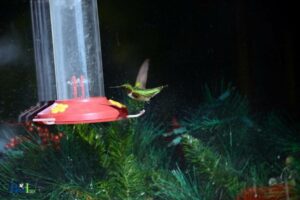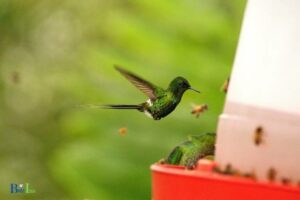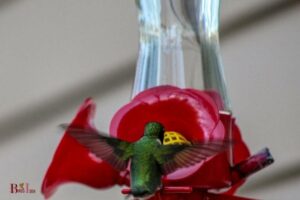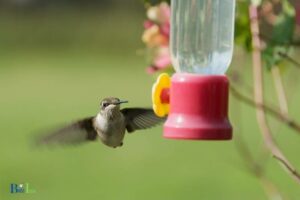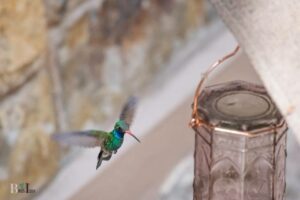How to Clean Hummingbird Feeders With Hydrogen Peroxide?
To clean hummingbird feeders with hydrogen peroxide, follow a simple process that involves emptying the feeder, creating a cleaning solution, soaking and scrubbing the feeder, and rinsing it thoroughly before refilling it.
Over time, hummingbird feeders can accumulate mold, mildew, and dirt, which can be harmful to the birds. Using hydrogen peroxide is an eco-friendly and effective way to clean and disinfect your hummingbird feeder without causing harm to the birds.
Hydrogen peroxide is an excellent cleaning agent due to its antimicrobial properties and ability to break down organic matter.
By simply mixing a solution of equal parts hydrogen peroxide and water, you can create an effective cleaning solution for your hummingbird feeder. After emptying the feeder, soak all its parts in the solution for at least 30 minutes.
Next, use a brush or sponge to scrub the feeder thoroughly, ensuring you reach all nooks and crannies. Once clean, rinse the feeder with warm water to remove any residue before refilling it and hanging it back up for your feathered friends.
10 Steps to Clean Hummingbird Feeders With Hydrogen Peroxide:
| Step | Description | Materials Needed |
| 1 | Gather materials | Hummingbird feeder, hydrogen peroxide, warm water, soft brush, gloves, goggles, sink or basin |
| 2 | Safety first | Put on gloves and goggles to protect your skin and eyes from the hydrogen peroxide |
| 3 | Prepare cleaning solution | Mix equal parts hydrogen peroxide and warm water in a sink or basin |
| 4 | Disassemble feeder | Remove the base, lid, and any other removable parts from the feeder |
| 5 | Soak feeder parts | Submerge all parts of the feeder in the cleaning solution and let it soak for 10-15 minutes |
| 6 | Scrub feeder parts | Using a soft brush, gently scrub all parts of the feeder, paying extra attention to crevices and hard-to-reach areas |
| 7 | Rinse feeder parts | Thoroughly rinse all parts of the feeder with clean water to remove any hydrogen peroxide residue |
| 8 | Air dry feeder parts | Allow all parts of the feeder to air dry completely before reassembling |
| 9 | Reassemble and refill feeder | Once all parts are dry, reassemble the feeder and refill with fresh nectar or sugar water |
| 10 | Hang feeder | Hang the feeder in a location that is easy for hummingbirds to access and enjoy |
Key Takeaway
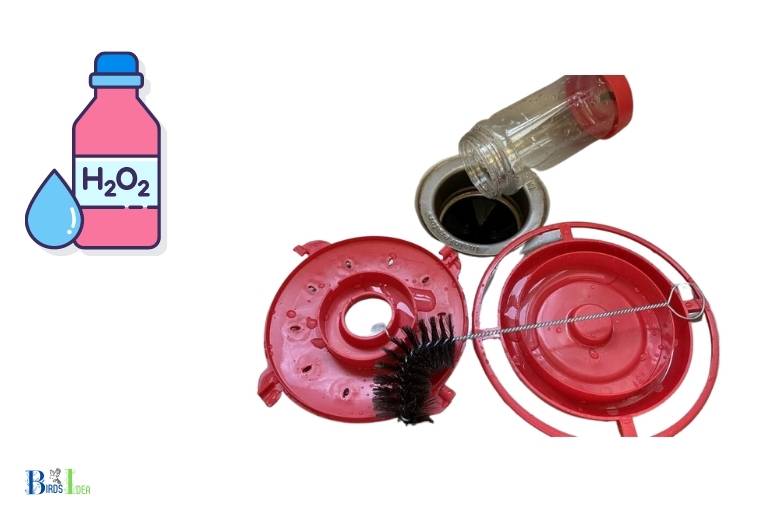
Five Facts About: Clean Hummingbird Feeders With Hydrogen Peroxide
The Importance Of Cleaning Your Hummingbird Feeder Regularly
Hummingbirds are a delight to watch. These tiny birds with colorful plumage are a joy to see flit around. It’s no wonder that many homeowners keep hummingbird feeders on their property to attract these delightful creatures.
While keeping a hummingbird feeder is a great way to invite them to visit, it’s important to remember the responsibility that comes with it.
Cleaning your hummingbird feeder on a regular basis is essential to ensure that your feathered friends stay safe and healthy. In this post, we’ll discuss the importance of cleaning your hummingbird feeder regularly, as well as the potential dangers of not doing so.
Hummingbird feeders can become a breeding ground for harmful bacteria and fungi if not cleaned properly. These can be extremely detrimental to the birds’ health and can lead to fatal consequences.
Regular cleaning of your feeder can prevent these harmful microorganisms from growing and protect the hummingbirds visiting the feeder.
Cleaning also ensures that the nectar remains fresh and sweet for the birds. Hummingbirds are attracted to the sweet taste of nectar, and if the feeder is dirty, it can cause the nectar to spoil and ferment quickly.
This will not only cause the hummingbirds to avoid the feeder but could also harm them if they ingest fermented nectar.
A clean feeder will also prevent the growth of mold and other contaminants which can clog the feeding ports. This can be particularly detrimental to the hummingbirds because they rely on the clean and proper functioning of these ports to feed.
The Potential Dangers Of Not Cleaning Your Feeder
If you neglect to clean your hummingbird feeder regularly, it can become a serious health hazard for the birds visiting it.
Some of the potential dangers of not cleaning your feeder include:
- The spread of diseases – dirty feeders can carry harmful bacteria and viruses that can be easily transmitted to birds. Some common diseases associated with unclean feeders include salmonella, avian pox, and aspergillosis.
- Nectar spoilage – old, stale or fermented food can be harmful to birds. It’s no different for hummingbirds as consuming contaminated nectar can lead to a variety of health problems, including dehydration, malnou
- Attracting pests – a poorly maintained feeder can also become a breeding ground for pests such as ants, wasps, and bees, with dangerous consequences for the birds.
Cleaning your hummingbird feeder regularly is paramount to the health and well-being of these beautiful birds. Not only does it help to prevent the spread of disease, but it also ensures that the nectar remains fresh and that the feeding ports are functioning correctly.
So, if you want to keep your feathered friends safe and ensure that they keep coming back to your feeder, it’s essential to give it a thorough cleaning every few days.
Tools And Materials Needed For Cleaning Your Hummingbird Feeder
Hummingbirds are lovely creatures that bring life to any garden or backyard. If you are a hummingbird enthusiast, you know the importance of keeping their feeders clean to ensure their safety and health.
Naturally, cleaning your hummingbird feeder with hydrogen peroxide is one of the best ways to guarantee your feathered friends’ well-being.
As such, we will explain what tools and materials you will need for the perfect cleaning process, as well as tips for selecting the best material for your feeder.
List Of Necessary Tools And Materials For The Cleaning Process
Cleaning your hummingbird feeder with hydrogen peroxide requires some special equipment to make the process smoother.
Here is a list of the necessary tools and materials for the cleaning process:
- Hydrogen peroxide
- Hot water
- A good-quality brush, preferably a bottle brush
- A clean and dry towel or paper towel
- Disposable gloves
- A plastic bucket or container
To make the cleaning process easier, it is best to assemble all the necessary tools and materials in one place before you start cleaning.
Tips For Selecting The Right Materials For Cleaning Your Feeder
When selecting materials for cleaning your hummingbird feeder, there are some tips to keep in mind.
Here are some essential tips to help you make the right choices:
- Use only food-grade hydrogen peroxide: Hydrogen peroxide with a concentration of 3% is ideal for cleaning hummingbird feeders. If you use anything higher, it can be harmful to the birds.
- Use hot water: Hot water helps dissolve sugar crystals that can build up inside the feeder, making it easier to clean.
- Choose the right quality of brush: A bottle brush is perfect for cleaning hummingbird feeders, as it can reach all the nooks and crannies. Make sure to select a good quality brush, so the bristles do not fall out and get trapped inside the feeder.
- Wear disposable gloves: Wearing disposable gloves protects your hands from coming into contact with any leftover sugar or mildew inside the feeder, ensuring your safety while cleaning the feeder.
- Clean your feeder regularly: Cleaning your feeder at least once every four days will keep it free from harmful bacteria or mold.
- Thoroughly rinse the feeder: After using hydrogen peroxide to clean your feeder, rinse it thoroughly with hot water to remove any residue of the cleaning solution.
- Use a dry towel to wipe your feeder: After rinsing, use a clean and dry towel or paper towel to dry the feeder. Leaving the feeder wet can encourage the growth of unwanted bacteria.
By keeping the above tips in mind, you will be able to select the best materials for cleaning your feeder and keep it clean and safe for your hummingbirds.
Cleaning your hummingbird feeder is vital in maintaining your feathered friends’ safety and health. By using hydrogen peroxide and the right tools and materials, you can clean your feeder efficiently and keep the hummingbirds happy in your backyard.
Step-By-Step Guide To Cleaning Your Hummingbird Feeder With Hydrogen Peroxide
How To Remove The Nectar And Debris From The Feeder:
Hummingbirds are lovely creatures, and it’s a delight to watch them hover and sip nectar from your feeder. However, with continuous usage, it is essential to clean the hummingbird feeder regularly to keep it safe for the birds.
Here’s how you can clean your feeder thoroughly:
- The first step to clean a hummingbird feeder is to remove any remaining nectar from the feeder.
- Once the nectar is removed, it’s time to disassemble the feeder to remove any leftover debris.
- Use a solution of warm water and mild soap and clean the feeder with a soft-bristled brush to remove any mold, dirt, and other debris.
- Rinse the feeder thoroughly with clean water to ensure there is no soap residue.
- Air dry the feeder completely before refilling it with fresh nectar.
Tips For Cleaning The Feeder Without Damaging It:
Cleaning a hummingbird feeder with hydrogen peroxide can be an effective and safe method as the chemical is naturally occurring and mostly harmless.
However, it’s essential to follow a few tips to clean the feeder without causing any harm or damage to it:
- Make sure to wear gloves while cleaning the feeder to avoid any contact with the hydrogen peroxide solution
- Ensure that every part of the feeder is thoroughly cleaned, including the tube ports, feeding tray, and the base.
- Do not use any abrasive materials like scrub pads or steel wool to clean the feeder, as it can scratch and damage the surface.
- Rinse the feeder thoroughly with warm water to remove any leftover debris or hydrogen peroxide solution before refilling it.
Step-By-Step Process For Safely Cleaning The Feeder With Hydrogen Peroxide:
Hydrogen peroxide can be an effective and safe option to clean your hummingbird feeder.
Here is a step-by-step process to help you clean your feeder thoroughly with hydrogen peroxide:
- Remove any excess nectar from the feeder.
- Disassemble the feeder into parts and soak them in a solution of one-part hydrogen peroxide and four parts warm water.
- Let the parts soak for about an hour, which will help to remove any mold, bacteria, or dirt that’s sticking to the surfaces.
- After an hour, use a small brush to scrub every part of the feeder thoroughly.
- Once the feeder is entirely clean, rinse it properly with clean water to get rid of any hydrogen peroxide residue.
- Allow the feeder to air dry before reassembling it and refilling it with fresh nectar for your hummingbird visitors.
In conclusion, cleaning your hummingbird feeder can be a simple and straightforward task with the right technique. Follow the above steps to keep your feeder free from debris and safe for hummingbirds.
How Often Should You Clean Your Hummingbird Feeder With Hydrogen Peroxide
Hummingbirds are a delightful sight to behold, but their feeders can easily become contaminated with bacteria, mold, and yeast. Hence, cleaning hummingbird feeders is as crucial as providing nectar to these beautiful birds.
While there are multiple ways to clean the feeders, cleaning them with hydrogen peroxide has become of utmost importance.
In this blog post, we’ll discuss the frequency and factors affecting the cleaning of hummingbird feeders with hydrogen peroxide.
Importance Of Frequency In Cleaning Your Feeder
Regular cleaning of hummingbird feeders is essential to maintain a healthy environment for hummingbirds.
Here are the key points to keep in mind:
- It is a good practice to clean your hummingbird feeder at least once a week.
- During the hot summer months, it is necessary to check the feeder more frequently as the heat speeds up bacterial growth.
- If you observe any mold or discoloration in the nectar, clean your feeder immediately and replace the nectar. Moldy nectar can be fatal to hummingbirds, and unclean feeders can lead to the growth of fatal diseases.
Factors That Can Influence How Often You Should Clean Your Feeder
Apart from adhering to a weekly cleaning schedule, several factors can influence the cleaning frequency of your hummingbird feeder.
Here are the key points to consider:
- Location: Place your feeder in a shaded area protected from direct sunlight. Direct sunlight speeds up the formation of harmful microorganisms, thus requiring more frequent cleaning.
- Temperature: Higher temperatures lead to faster bacterial growth, thus requiring increased cleaning frequency.
- Humidity: High humidity levels can also contribute to the growth of bacteria and mold. In such cases, cleaning the feeder more often can prevent the growth of microorganisms.
- Number of feeders: If you have multiple hummingbird feeders, it is best to rotate them and clean every feeder before refilling to provide a clean and healthy environment for the hummingbirds.
Cleaning hummingbird feeders with hydrogen peroxide is an easy and efficient way to maintain cleanliness and hygiene.
By adhering to a regular cleaning schedule and considering the various factors affecting the cleaning frequency, you can provide a healthy environment and pleasant feeding experience for the hummingbirds.
Tips For Maintaining A Clean And Healthy Hummingbird Feeder With Hydrogen Peroxide
Hummingbirds are one of the most charming and delightful birds to watch. If you own a hummingbird feeder, it is essential to clean it to prevent mold and bacteria growth that could harm hummingbirds.
This article will provide you with some useful tips for maintaining a clean and healthy hummingbird feeder using hydrogen peroxide.
How To Prevent Mold And Bacteria From Growing In Your Feeder
Mold and bacteria growth are common problems that can be dangerous for hummingbirds if the feeders are not cleaned adequately.
Here are some useful tips to prevent mold and bacteria growth in your feeder:
- Regularly clean your feeder at least once a week or more if the weather is hot and humid.
- Use a solution of 1-part white vinegar and 4 parts water to clean all parts of the feeder, including the feeding ports, base, and lid.
- If you see signs of mold or bacteria growth, use a small bottle brush or pipe cleaner to clean the ports thoroughly.
- Rinse the feeder thoroughly with clean water and let it dry completely before refilling it with fresh nectar.
Ways To Ensure That Your Feeder Remains Clean And Healthy For Your Feathered Friends
Apart from cleaning the feeder with white vinegar and water, here are some other tips to ensure that your feeder remains clean and healthy for your feathered friends.
- Use a brush or sponge to clean the feeding ports and other hard-to-reach areas that cannot be cleaned with a pipe cleaner.
- Replace any worn or damaged parts of the feeder to avoid leaks and cracks that could collect dirt and algae.
- Position your feeder in a shaded area to prevent the nectar from fermenting too quickly.
- Consider rotating different feeders so that one can be cleaned and dried without the birds going hungry.
- Check the nectar every few days and replace it if it looks cloudy or has an off smell.
Other Tips For Protecting The Health And Safety Of Your Hummingbirds
Keeping your hummingbird feeder clean and well-maintained is crucial, but there are other steps you can take to protect the health and safety of your hummingbirds.
- Only use white granulated sugar to make nectar, mixed at a ratio of 1 part sugar to 4 parts water. Do not use honey or artificial sweeteners.
- Never use red food coloring on the nectar as it can harm the birds.
- Clean and sanitize the hummingbird feeder more frequently during the warmer months when mold and bacteria growth are more prevalent.
- Keep the feeders away from windows and other obstacles that could cause birds to fly into them.
- If you find a sick or injured hummingbird, call a licensed wildlife rehabilitator or local bird rescue for assistance.
Hummingbird feeders are a delight to watch, especially when they are full of these beautiful birds. Keep your feeder clean and healthy with these tips, and you will be rewarded with more frequent visits from these charming and colorful birds.
FAQ For How To Clean Hummingbird Feeders With Hydrogen Peroxide
How Often Should I Clean My Hummingbird Feeder?
Can I Use Dish Soap To Clean My Hummingbird Feeder?
Is It Safe To Use Hydrogen Peroxide On My Hummingbird Feeder?
How Do I Know If My Hummingbird Feeder Is Clean Enough?
Conclusion
As a hummingbird enthusiast, keeping their feeders clean and healthy is crucial for the well-being of these charming creatures. Using hydrogen peroxide to clean hummingbird feeders is an excellent way to ensure that the nectar remains free from harmful bacteria and mold.
It’s a simple and effective solution that can save you from throwing your favorite feeder away. Just remember to rinse well and take additional precautions to keep the feeding station clean and safe.
By following these simple steps, you can provide a haven for hummingbirds and enjoy their delightful presence in your backyard.
So, stock up on hydrogen peroxide and let this solution be your go-to for keeping your hummingbird feeders sparkling clean and full of nectar. Happy bird watching!

